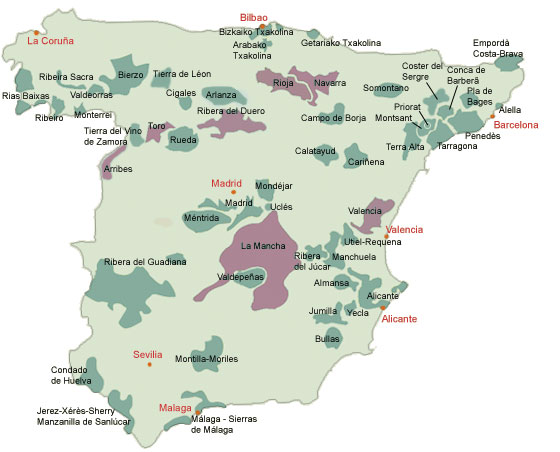
It is a Mediterranean climate with some Atlantic influences. There is light rain through out the growing cycle, and summers are hot, sunny, and dry. During the summers the slope of the land and the orientation of the mountainside augment the power of the sun.
The soil is sandy with loose pieces of granite and quartz. There are rocky outcroppings and small amounts of organic matter. The subsoil is perfect for drainage, and actually forms in such a way that helps to regulate the difference of daytime and nighttime temperatures. During the day the is soaked up into the ground and gradually releases throughout the night, creating optimal conditions for the maturation of the grapes.
This area is known for their production of the Airén for brandy production. But, a few of winemakers are now using this varietal to makie crisp, pleasant white wines. Tempranillo is the most common red varietal, but a great variety of both white and red varietals can be found in this region.
The most common native varietal is Garnacha, but in the past 15 years the amount of Garnacha has gone down by half. Now you can find many plantings of Tempranillo, as well as Cabernet Sauvignon, Merlot, and Chardonnay. There are some very dynamic families and producers in Navarra, and great value, as well as surprising wines, should remain the hallmark of the region.
The valley of the Ribera del Duero folds around the Duero River and is nestled amongst pine trees. The soil has alluvial deposits that rise up through clays, sand, and chalk in varying amounts. Closer to the river alluvial soils dominate, but marl and schist are also found. On the higher hillsides and in the eastern part of the region limestone dominates. The subsoil also varies across the region.
More than 90% of the plantings in the region are Tempranillo (also called Tinta del País or Tinto Fino), although some of the 90% includes mixed plantings. Cabernet Sauvignon, Merlot, and Malbec all have been in the region for decade.
Perhaps the most important factor in the style of these wines is the drastic diurnal shift, it is not unusual that the temperatures to drop by as much as 50°F at night. The Tinto Fino loves this climate.
Within the region there are three subregions: Rioja Alavesa, Rioja Alta, and Rioja Baja. Rioja Baja and Rioja Alta have similar soil types characterized by iron-rich, limestone-clay soils, interspersed with alluvial soils from the many rivers that carve through the area. Distinct to the Baja region is a laye of limestone that is often found less than a foot below the topsoil. As their names suggest there elevations are different, with Alta being higher. The Alavesa is at a high elevation and has chalky soils, which creates wines of less color and greater perfume, more longevity, and less power at birth. The traditional wines of Rioja have always used blends of wines from all three areas, although this is not as common now.
The entirety of the Rioja region benefits from the angle of the mountains that surround it. They are protected from the coldest of the Atlantic air masses but are still influenced by the nearby ocean. The angleof the mountains also allows for a Mediterranean influence from the south.
Over 80% of the varietals are red, with an emphasis on Tempranillo. There is also a good amount of Garnacha, especially in the Baja subregion. Small plantings of Mazuelo (Carineña) and Graciano can also be found. Among the white varietals Viura is the most widely planted, and is ideal for those interested in a fresher, more modern style. There are also some old Malvasía vines, which are traditional to the region.
The elevations are slightly lower than Ribera del Duero to the east, the land is a bit flatter, and yields can be quite generous. But the happily vexing issue is how, even with higher yields, the wines can be so intense, which is true for both the older and younger vines. Some of the century–old bush vines offer yields that would make a young vine blush, and they lose not a bit of quality in the process. It's an amazing and intriguing region.
The soil is made up of sandy sediment, clay and calcareous conglomerates from the Pliocene. The materials alternate from loamy materials to large and fine grand sand, with limestone and detrytic marl formed during the Milocene. The climate is a dry continental climate with cold winters, and a lot of sun.
Valencia is split into four subzones: Alto Turia, Valentino, Moscatel de Valencia, and Clariano. Alto Turia and Valentino are high up in the mountains on the northern side of the region. Moscatel de Valencia, which as the name suggests is well known for their Moscatel dessert wines, is close to the city of Valencia. Clariano is on the southern side of the area near Alicante. Vineyards in this DO can be found at sea level as well as high as 3,200 ft. The majority of the vineyards though lie at about 1,600ft.
Most of the vineyards include large proportions of limestone, but marl, clay, sandstone, and gravel can all appear and impact the wines. Grapes include all manner of Mediterranean and international grapes, as well as locals such as Merseguera, Malvasia, Pedro Ximénez, Pedralba, Planta Nova (a white, not Bobal), Tortosi, Verdil, Alicante Bouschet (yes, they call it Garnacha Tintorera), and Bonicaire.